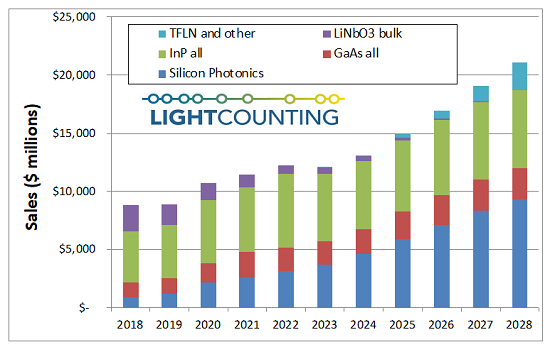Many industry insiders predict that silicon optical (SiP) will enable inexpensive, mass-produced optical connectivity, fundamentally changing the optical device and module industry. Predicting when this shift will occur is quite challenging: nothing seems to happen for a while, until suddenly, change appears for all to see. In case you haven't noticed, silicon optical is currently one of the dominant technologies in the global optical transceiver market, as shown in the figure below.
LC expects the market share of silicon-based optical modulator transceivers to rise from 24 per cent in 2022 to 44 per cent in 2028. More interestingly, modulators based on other thin-film materials can be fabricated on silicon wafers and use silicon light as an integration platform with a variety of optical components and electronic ICs. These materials currently include thin-film lithium niobate (TFLN), barium titanate (BTO), and electro-optic polymers, which LC has combined into the "TFLN and others" category in the chart.
Another exciting shift in the industry is the adoption of linear drive pluggable (LPO) transceivers and co-packaged optics (CPO). Both solutions significantly reduce power consumption compared to standard retiming transceivers with built-in PAM4 DSP chips. Removing the DSP saves power, but requires more complex SerDes for direct drive.
Broadcom's 100G SerDes was developed with CPOs in mind, but it appears to support LPOs as well. initial performance of 800G LPO modules driven by 100G SerDes has been very encouraging. However, LPOs are unlikely to work with 200G SerDes, so CPOs may be the only option for 1.6T ports.
Will all LPO and CPO solutions be based on silicon optical technology? Most likely not, but silicon optical is the current leader and the ideal integration platform for new materials. Silicon modulators are currently the best choice for linear drive designs, as GaAs direct modulated lasers (DMLs) and InP electro-absorption modulated lasers (EMLs) are more "non-linear" devices. Perhaps not all solutions will use silicon optical modulators, but it is certain that all LPO/CPO devices will be based on silicon optical platforms, with the exception of VCSELs. All new materials (TFLN, BTO and polymers) will be integrated with other optics and electronics using the silicon optical platform.
Traditional retimable pluggable products will continue to dominate the market for the next 5 years and beyond. However, LPO/CPO ports will account for more than 30 per cent of the total number of 800G and 1.6T ports deployed in 2026-2028. As usual, nothing may happen for some time until suddenly this change comes to all of us.
From ICCSZ Reprinted: http://www.iccsz.com//Site/CN/News/2023/05/31/20230531012246244281.htm


